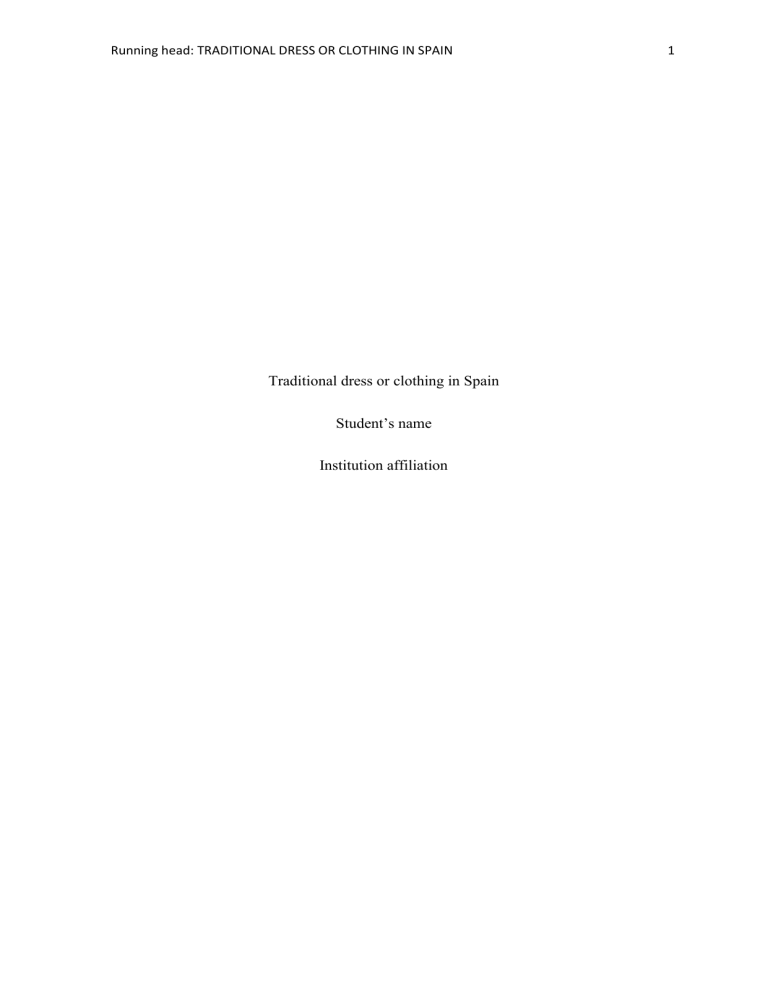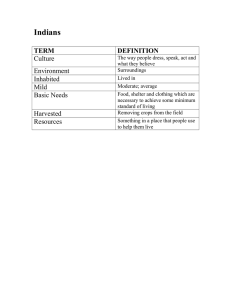
Running head: TRADITIONAL DRESS OR CLOTHING IN SPAIN Traditional dress or clothing in Spain Student’s name Institution affiliation 1 TRADITIONAL DRESS OR CLOTHING IN SPAIN 2 Under male sexual garments, farthingales had klaxon ring skirts constructed of fiberglass, fabric, and elaborate metal enclosures. For Golden age females, the design was heavy, and changing clothes took hours. The Moorish culture, which ruled sections of the Iberian Peninsula from 711 AD to 1492, had a heavy impact on traditional Greek attire. With the adoption of pearls and scents, as well as thick bodysuits and collars, the Moorish society favored beautiful needlework. For important occasions, the black color grew trendy, and that both males and females donned gold chain collars with expensive gemstones. In Spain, clothing was frequently composed of costly, structural steel and embellished with precious metal strands. However, these Spanish designs were unable to adapt to the constantly shifting conditions. As a response, classic clothing would ultimately fall obsolete, and French flair would take its place. But traditional Spanish clothing is still worn for special events. However, classic attire is used for formal days. The dancers still appear traditionally in scarlet, dark, or pale, wearing long hair in a ponytail and roses below her ears. Typically gender dance attire comprises of dark or light formal sleeves and elegant pants. The ornate clothes worn by classic rodeo clowns had largely been constant over time and yet are influenced by flashy eighteenth Seville design. The use of rhinestones, gems ribbons, and exquisite needlework distinguishes them as "coats of colours. Aside from such English gowns for unique performances, each Spaniard province seems to have its own unique apparel and Spanish gowns. These were rarely seen, however, they are frequently seen at community festivities including demonstrations. Most traditional clothing was for special events, for example, the mantilla was worn during special occasions like religious occasions and the most common pieces are still used today, the Peineta it was also used in special occasions and it was made from a shell and the Gilet a sleeveless jacket, it was used in maintaining warmth (Don, 2021) TRADITIONAL DRESS OR CLOTHING IN SPAIN 3 As an important part of Spanish culture, each region had its attire as a result of Roman, Arab, Berber, and Latin mixture. The clothes may be seen at festivals as they are not worn on normal days. For example, the traje de Flamenca or ‘Flamenca outfit is a female outfit won at festivals. There are two versions of flamenco outfits worn by dancers and worn regularly. The dressing varied from community to community the Fallero and fallera were worn in festivals but they were already worn by the Valencian citizens in the eighteenth century. At the beginning of the eighteenth century, the Farella was a typical dress for farmers but later it came for farmers, the cheapo dress was worn by men to women during a cultural function called the san Isidro celebration in May. The barseritara were very diverse as each region had its own outfit. On one extreme, females used this to dress in a thick flowing frock with just a gray belt, a striped blouse, and a crimson hijab. People can wrap cashmere shawls across their arms if the temperatures drop. Males, and on the other hand, dress in shirts and ties and shorts with crimson ribbons and a txapela across their heads (embassy, 2016). Each year on July 7th, the town of San Fermin hosts the world-famous bullfight. The guys wear bright collars and white silk slacks, with red scarves around their necks and waists. These clothes are available for purchase at stores all across the city for anyone interested in joining. Ladies are not permitted to run with both the bulls because it is regarded as a masculine game; but, if a feminine visitor wants to do so, she will not be opposed and will be prepared to look after oneself during the frenzied dash to beat the animals through all the cobbled. This indicates that there were specific attires worn at specific functions or festivals. Females are provided with appropriate ivory dresses or slacks to match into the rest of the festivals. Potential opportunities include a procession commemorating the state's patron and a presentation that features gigantic with huge heads. Every year, about three million people attend the celebrations, providing an even financial benefit to the country. TRADITIONAL DRESS OR CLOTHING IN SPAIN 4 The clean outfit suggestions include clothes that are easy to wash and will not get irreversibly ruined by the iconic red Margarita. The shattered glass would make its way into almost every street during the celebration, thus exposed shoes must be discouraged. Bullfights have elaborate systems. Bullfights in Spanish are marked by complex conventions for the toreador and everybody else engaged in the arena. The most well-known is the bullfighter's clothing, which is designed to be as intimate to the skin as taken to prevent the bull's claws from penetrating the textile and dragging the matador to his demise. The outfit's colours are often inspired by the blues of the Catalan emblem along with specific allusions. Bullfighters become celebrities amongst flamenco fans, but the more well-known and well-paid they are, the more ornate their clothing becomes, particularly when the bouts will be telecast to huge audiences and the cash reward is extremely large. Everyone in the ring has a certain job to play, and they must be dressed accordingly for the occasion and their assigned station. To assist, the Picador sits on the horse. Regional costumes were worn in public festivities like performing for an audience like music performances. There are variations in traditional costumes per region in every festivities, the embroideries happen to be colourful depending on the historical events at the moment. When for example celebrating the victor people tend to dress in white or red to symbolize peace or suffering Veils, mantillas, and scarves embellish the women's headpiece, which are classic depictions of bygone ages. Male sexual costumes try to associate the female's clothing as well as the time frame they portray. Boots are just as significant also like the rest of something like the clothing, and it often mimics combat boots or basic wrapped wedges manufactured of hemp or other natural elements, which were once worn among goatherds and farmers. Costume in France is as diverse as the culture of the country's different regions and the importance of the various festivals. (Durant, 2021) In classical Spanish dress, the Spaniard design affected most of Western Europe during the middle ages, and even though the design was bulky and unwieldy for ladies, it was regarded as TRADITIONAL DRESS OR CLOTHING IN SPAIN 5 the pinnacle of elegance, even though changing clothes took hours. Spaniard robes and bodices were quite fashionable among Britain and Westernized females. Klaxon ringtails constructed of long fibres and copper were being used beneath garments to give height and simulate an amazing body. Farthingales were always the name for these creatures. Thick textiles were used to make the bodysuits and dresses, which were often embellished with manually stitched, colourful motifs or even stones. Elaborate golden collars were worn by women and ladies, and the black population was associated with special events. In Traditional Festivals, Spaniards Start Dressing Once the global apparel industry went on, classic clothing kept the same but, and Subculture updated to accommodate those shifts. Most Spaniards still wear traditional dress on certain holidays to show their culture, and travellers can sometimes watch certain shows and dramas including classic attire. On big events, Tapas and Tango performers may typically wear wearing Traditional clothes, commonly in scarlet, charcoal, and ivory, with hands stuck in a ponytail for females and a bloom behind ears. Gentlemen will typically wear formal blouses and trousers in dark or burgundy. At worship and marriages, the Mantilla is frequently donned. It's a linen or satin scarf with pins that are placed out over the forehead or arms like a shroud. One classic Hispanic instrument that is frequently utilized is the quilted vest. (Alan et al, 2012) It's been such a long time since I've worn a terno dress. It sprang out of the initial Spanish times (the 1700s), the revolt versus Spain and the PhilippineAmerican War (Victorian Era), the American colonial period, two World Wars, the atomic age, and the Marcos regime's totalitarian reign... plus a little more. A quick history lesson: the terno is based just on traditional Filipino women's outfit that includes a blouse a folded hexagonal item of textile made to wear well over forearms as well as a short hexagonal cloth encased over the end of a very long gown Women throughout Luzon and Visayas used similar gowns in tiers in striped and chequered designs as a show of affluence during the early Spanish era. Some traditional dressings have meanings of maybe a massacre that happened a TRADITIONAL DRESS OR CLOTHING IN SPAIN 6 little while before as in the invasion of Ibiza by the Catalans was yet another bloodbath, with the percentage of men killed as well as the remainder imprisoned. "The destabilization had been that receptive initiatives with individuals from Tarragona would have to be conducted out," according to this essay (translation) in "Diario de Ibiza. “However, keep in mind that in Ibiza, as in the other Balearic Islands, salty vocabulary is utilized, which is definitely not the case in Tarragona. And Ibiza's decor has no resemblance to that of Tarragona or the other islands. People from Tarragona, predominantly men, most likely mingled with Ibizan ladies. Ladies who carried down their Ibizan romantic cultural heritage to their descendants. Similarly to how offspring of females from Ibiza or the rest of the Group Of islands who are married or engaged from elsewhere in the Italian Peninsula are treated now. (Apocrypha, 2021)Cataula’s done accurately is known as 'strange Devereux for males and 'strange de papilla' for females. The 'bar retina,' a type of woolly, wide helmet, typically violet or scarlet, and the 'faixa,' a thick belt for males, and there,' a small net covering and over the forehead for women, are all part of it. The espadrille, or 'espardenya,' is the most popular footwear. While this is by no means a full collection of famous Traditional clothes, it should suffice to give you a flavour of the diversity for an offer in Spain. (Embassy, 2016). The attires had a meaning and were also won in specific functions like the ones won in weddings were different from ones won in sports and games and as well they differed from different regions as people had different cultures. Some communities developed attires from their past calamities, for example, a Spanish community were a certain cloth in remembrance of a drought season which invaded their area and caused many losses on the communities members at large or even from a disaster which caused bloodsheds of almost the whole village so they have certain traditional dresses which are won in the remembrance of the past or also to pay respects to their kinsmen who were affected by the disaster which caused lives. In a moment of happiness which a community celebrates to be happy they wear certain clothes or TRADITIONAL DRESS OR CLOTHING IN SPAIN 7 even traditional dresses to show it sometimes communities even wear colours which represents a certain thing like colour red which represents danger, massacre or even death which affected some people at a large number of others a white cloth which symbolizes peace which they got maybe by gaining independence over a long struggle so the day for the commemoration one wears a white dress in remembrance of the day when they are going to celebrate like the Spanish they remember the Catalans when they dud them massacre at their land. Some traditional dresses which reflect culture are like the ones used in religious ceremonies or even traditional festivals in a certain area to show the seriousness of an event or how it happened a long time ago like high crop yields which made people happy and comfort about it. People of different communities tend to know how culture helps them so they mark it by having a specific traditional dress to wear in their lives or even in a group of people with their ways to pay respects. TRADITIONAL DRESS OR CLOTHING IN SPAIN References Quixote D, 1986 https://www.donquijote.org/student-services/our-history/ Durant W, 2011 https://www.brighthubeducation.com/social-studies-help/124019-traditionalspanish-clothing-history/ Apocrypha M, 2021 https://www.mallorcaapocrifa.com/dress.html Mentoring C, 2021 https://vintagallery.com/blogs/news/the-filipiniana-dress-the-rebirth-of-the-terno 8


